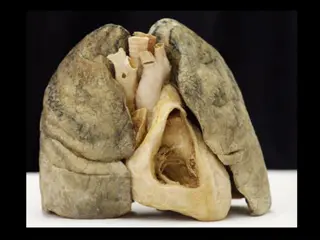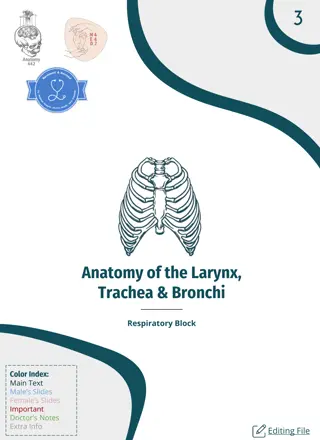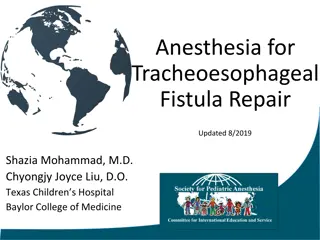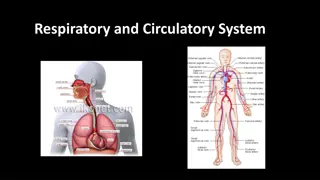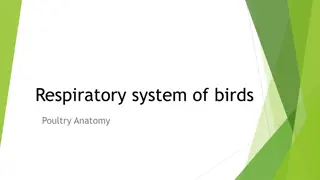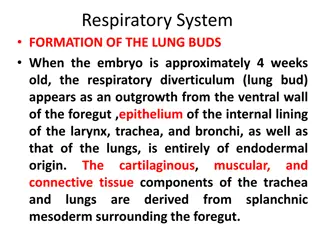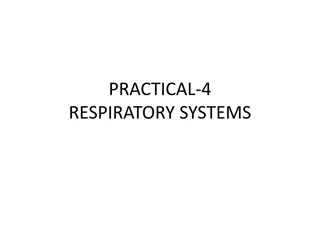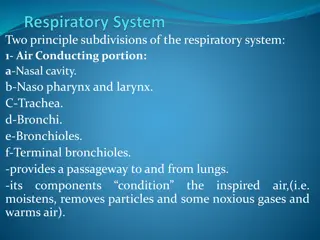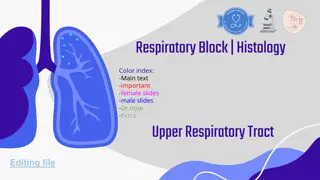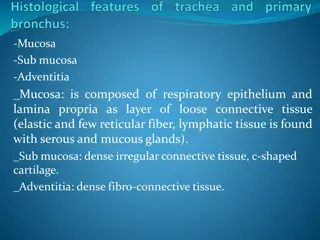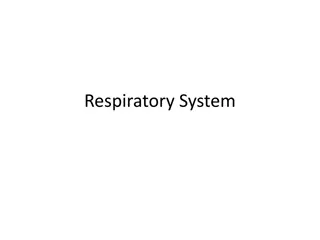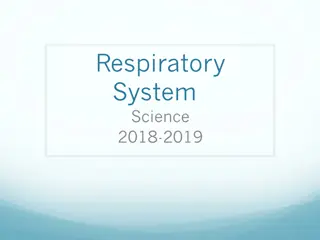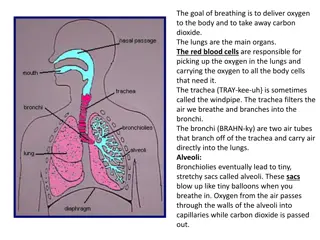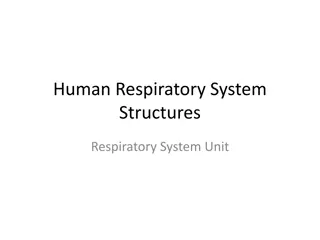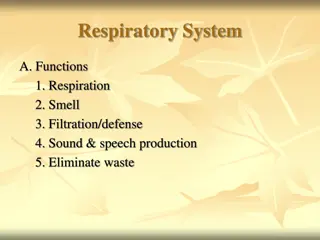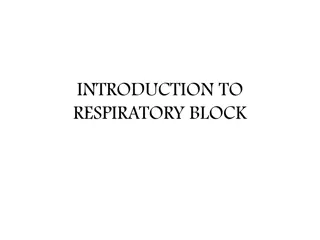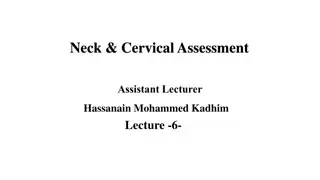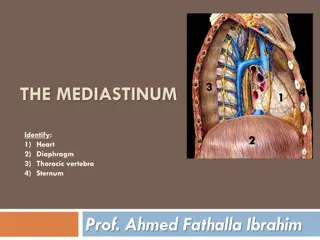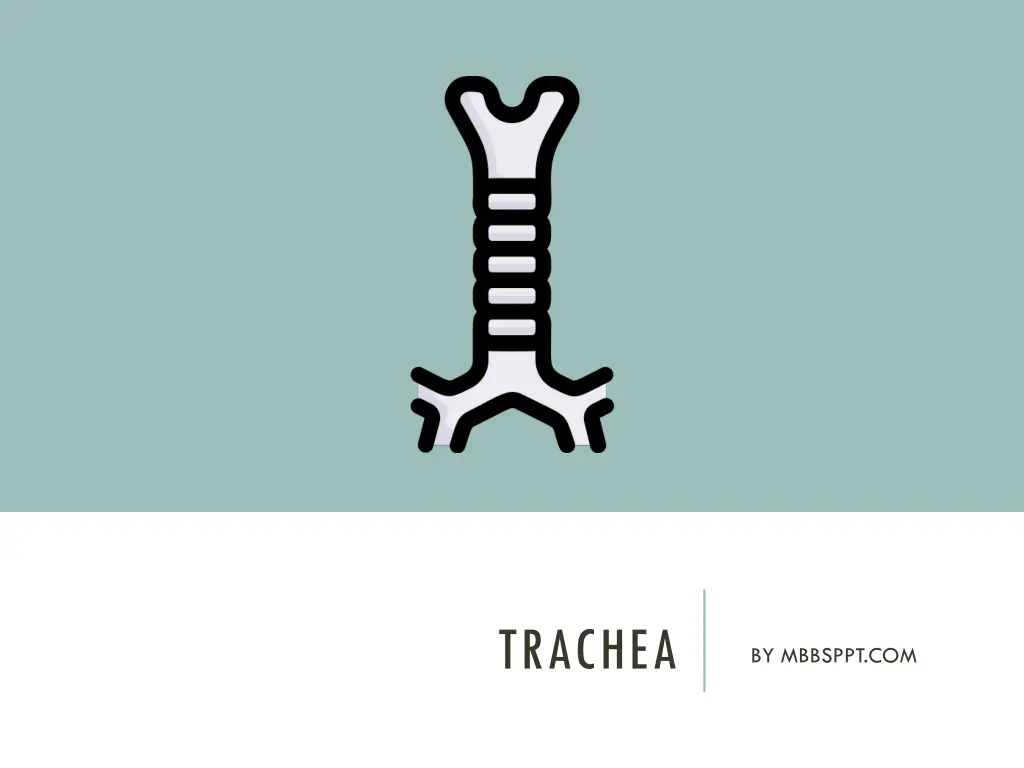
Trachea Anatomy: Structure, Function, and Position
Discover the intricate details of the trachea, also known as the windpipe, including its fibrocartilaginous nature, anatomical position, and role in the respiratory system. Learn about the tracheobronchial tree and measurements of the trachea, providing a comprehensive overview of this vital organ. Explore images and descriptions to enhance your understanding.
Download Presentation

Please find below an Image/Link to download the presentation.
The content on the website is provided AS IS for your information and personal use only. It may not be sold, licensed, or shared on other websites without obtaining consent from the author. If you encounter any issues during the download, it is possible that the publisher has removed the file from their server.
You are allowed to download the files provided on this website for personal or commercial use, subject to the condition that they are used lawfully. All files are the property of their respective owners.
The content on the website is provided AS IS for your information and personal use only. It may not be sold, licensed, or shared on other websites without obtaining consent from the author.
E N D
Presentation Transcript
TRACHEA BY MBBSPPT.COM
THE TRACHEA The Trachea is also called windpipe and it is a fibrocartilaginous, non- collapsible tube that creates the beginning of the lower respiratory tract. 16-20 C-shaped rings of Hyaline cartilage keep its lumen patent. A band of smooth muscle (Trachealis) and a fibroelastic ligament that bridges the gap between the posterior free ends of C-shaped cartilages, that allow expansion of esophagus during the passage of bolus of the food.
THE TRACHEA The trachea, bronchi and bronchioles form the tracheobronchial tree a system of airways that allow passage of air into the lungs, where gas exchange occurs. These airways are located in the neck and thorax. The arrangement of cartilages and elastic tissue in the tracheal wall prevents its kinking and obstruction during the movements of the head and neck.
ANATOMICAL POSITION The trachea marks the beginning of the tracheobronchial tree. It arises at the lower border of cricoid cartilage in the neck, as a continuation of the larynx. It travels inferiorly into the superior mediastinum, bifurcating at the level of the sternal angle (forming the right and left main bronchi). As it descends, the trachea is located anteriorly to the esophagus, and inclines slightly to the right.
ANATOMICAL POSITION Trachea stretches from the lower border of cricoid cartilage at the lower border of the C6 vertebra to the lower border of T4 vertebra in supine position, where it ends by dividing into left and right main bronchi.
MEASUREMENTS The upper half of trachea can be found in the neck (cervical part) on the other hand the lower half is located in the superior mediastinum of the thoracic cavity (thoracic part). The trachea is a 4-4 inches (10-11 cm) long tube. The diameter of trachea is 2 cm in men and 1.5 cm in females. The lumen is smaller in living human than that in cadavers.
LOCATION Thus upper half of the trachea lies in the neck (cervical part). Lower half in the superior mediastinum (thoracic part). Through its whole course, it lies directly in front of esophagus. Left recurrent laryngeal nerve lies in the groove between it and left border of esophagus.
STRUCTURE The trachea consists of about 16-20 C-shaped rings of hyaline cartilage being located one above the other the cartilages are deficient posteriorly where the gap is filled up by connective tissue and involuntary muscle termed trachealis. The absence of cartilages on the posterior aspect enables expansion of esophagus during deglutition.
COURSE The trachea is the continuation of the larynx. It begins at the lower border of the cricoid cartilage in the level of C6 vertebra, about 5 cm above the jugular notch. It enters the thoracic inlet in the midline and enters downwards and backwards behind the manubrium to terminate by bifurcating into 2 principal bronchi, a little to the right side at the lower border of T4 vertebra at the level of sternal angle where arch of aorta deviates it to the right. As trachea descends, it recedes rapidly from the surface to follow the curvature of vertebral column.
CERVICAL PART OF TRACHEA The cervical part of the trachea is all about 7 cm in length and stretches from the lower border of cricoid cartilage to the upper border of manubrium sterni (jugular notch). It goes downwards and somewhat backwards in front of the esophagus following curvature of the cervical spine and enters the thoracic cavity in the median plane with small deviation on the right side.
RELATIONSHIPS OF THE CERVICAL PARTS OF TRACHEA Anteriorly (from superficial to deep) Skin Superficial fascia including anterior jugular veins and jugular venous arch (crossing in the suprasternal space of Burns) Investing layer of deep cervical fascia Sternothyroid and sternohyoid muscles Isthmus of thyroid gland in front of the second, third and 4th tracheal rings Inferior thyroid veins Left brachiocephalic vein in kids may rise in the neck Thymus gland (in kids) Brachiocephalic artery (occasionally) in kids Posteriorly Esophagus Recurrent laryngeal nerve in the tracheoesophageal groove (on every side) On every side it s related to: Lobe of thyroid gland going to the 5th or 6th tracheal ring Common carotid artery in the carotid sheath
THE RELATIONS OF THE TRACHEA IN THE SUPERIOR MEDIASTINUM OF THE THORAX Anteriorly: The sternum, The thymus, The left brachiocephalic vein, The brachiocephalic trunk Left common carotid arteries, The arch of the aorta Superior vena cava (anterolateral) Deep cardiac plexus Posteriorly: The esophagus The left recurrent laryngeal nerve Vertebral column Right side: The azygos vein, The right vagus nerve, Right lung and the pleura Left side: The arch of the aorta, The left common carotid Left subclavian arteries, The left vagus and Left phrenic nerves, Left lung & pleura
THE UNIT OF 4 STRUCTURES IN THE POSTERIOR PART OF SUPERIOR MEDIASTINUM (3 tubes & 1 nerve) The esophagus. The traches. The thoracic duct. The left recurrent laryngeal nerve. These structures are related to each other and run parallel course through posterior part of superior mediastinum. The esophagus, lies directly on the vertebral bodies of the region. The trachea, lies directly in front of esophagus. The thoracic duct, ascends along the left border of the eso. The left recurrent laryngeal nerve ascends in the angle between the trachea and the esophagus.
SITES OF CONSTRICTIONS OF THE TRACHEA At its upper end: By the thyroid gland. At its lower end (near bifurcation): By the arch of aorta. Behind the manubrium: By the brachiocephalic artery.
HISTOLOGY MUCOSA It is composed of lining epithelium and lamina propria. Lining epithelium is pseudostratified ciliated columnar with few goblets cells. Lamina propria is composed of longitudinal elastic fibers. SUBMUCOSA It is composed of loose areolar tissue consisting of large number of serous and mucous glands. Cartilage and smooth muscle layer: It s created from horseshoe-shaped (C-shaped) hyaline cartilaginous rings, that are deficient posteriorly. The posterior gap is filled up chiefly by the smooth muscle (trachealis) and fibroelastic fibers. Perichondrium: It encloses the cartilage. Fibrous membrane: It is a layer of dense connective tissue, consisting of neurovascular structure. There s no clear difference between lamina propria and submucosa.
VASCULAR SUPPLY AND LYMPHATIC DRAINAGE A. Blood supply to the trachea is by inferior thyroid arteries. B. Venous drainage of the trachea takes place into the left brachiocephalic (innominate) vein. C. Lymphatic drainage of the trachea is into pretracheal and paratracheal lymph nodes.
NERVE SUPPLY This is by sympathetic and parasympathetic fibers. The parasympathetic fibers are originated from vagus via the recurrent laryngeal nerve. These are secretomotor and sensory to the mucus membrane and motor to the trachealis muscle. The sympathetic fibers are originated from the middle cervical sympathetic ganglion. These are vasomotor in nature.
TRACHEAL SHADOW IN RADIOGRAPH It is viewed as a vertical translucent shadow in front of cervico-thoracic spine. The translucency is because of the presence of air in the trachea.
PALPATION OF TRACHEA Medically, trachea is palpated in the suprasternal notch. Normally, it is median in position but appreciable shift of trachea to left or right side indicates the mediastinal shift.
IMPORTANCE OF CARINA It is a keel-like (hook-shaped) median ridge in the lumen in the bifurcation of trachea. It is both functional and pathological importance. Functional importance: The mucosa of trachea over the carina is most sensitive. The cough reflex is generally started here, which helps to clear the sputum. Pathological importance: It is visible as a sharp sagittal ridge in the tracheal bifurcation during bronchoscopy, for this reason acts as a useful landmark. It is located about 25 cm from the incisor teeth and 30 cm from the nostrils. If the tracheobronchial lymph nodes in the angle between the main (principal) bronchi are enlarged because of spread of bronchiogenic carcinoma, the carina becomes distorted and flattened.
IMPORTANCE OF CARINA It is a keel-like (hook-shaped) median ridge in the lumen in the bifurcation of trachea. It is both functional and pathological importance. Functional importance: The mucosa of trachea over the carina is most sensitive. The cough reflex is generally started here, which helps to clear the sputum. Pathological importance: It is visible as a sharp sagittal ridge in the tracheal bifurcation during bronchoscopy, for this reason acts as a useful landmark. It is located about 25 cm from the incisor teeth and 30 cm from the nostrils. If the tracheobronchial lymph nodes in the angle between the main (principal) bronchi are enlarged because of spread of bronchiogenic carcinoma, the carina becomes distorted and flattened.
TRACHEOESOPHAGEAL FISTULA (TEF) The most common congenital. Usually, it is combined with some form of esophageal atresia. In the most common type of TEF (approximately 90% of cases), the superior part of the esophagus ends in a blind pouch and the inferior part communicates with the trachea (A). In some cases, the superior esophagus communicates with the trachea and the inferior esophagus joins the stomach (B). Sometimes, TEF exits with esophageal atresia (C). TEFs result from abnormalities in partitioning of the esophagus and trachea by the tracheoesophageal septum.

